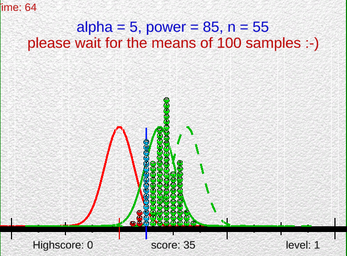Distribution
Adjust. Predict. Test. Repeat.
Distribution is a challenging educational game that helps you develop a visual and intuitive understanding of statistical hypothesis testing — including alpha errors, beta errors, statistical power, and the sampling distribution of the mean.
Each round begins with the red curve:
the sampling distribution under the null hypothesis (H₀).
Your task: adjust the blue marker (via drag & drop) to set the alpha cutoff.
For example, if alpha = 5%, move the blue line so that 5% of the red curve lies to the right.
Once your choice is made, the game compares your marker (dashed blue) with the correct solution (solid blue). The closer you are, the more points you score.
Now it's time to set the H₁ distribution:
Use the green marker to place the mean of the alternative hypothesis such that the desired power is reached (e.g., 85%).
In other words: place the green curve so that 85% of it lies right of the blue cutoff.
Again, dashed = your guess, solid = correct.
Then... the fun begins.
100 smiley-faced Dotkins fall, each representing the mean of a random sample drawn under H₁.
-
✅ Dotkins that land within both green curves and to the right of the cutoff turn green → they score points
-
❌ Dotkins that fall left of the cutoff (despite H₁ being true) turn red → beta error
-
⚪ Dotkins within the true H₁ distribution but outside your predicted one are blue → close, but no score
The distribution width changes with sample size (n) – smaller n means greater spread, as the standard error increases.
🧠 Built to make statistical decision theory interactive
📏 Developed with students in mind
🥎 Featuring 100 bouncing Dotkins per round!
Code and concept by Wolfgang Trapp, with a sprinkle of AI support (ChatGPT) for structure and wording.
All Dotkins are handmade. No statistical creatures were harmed in the making of this game.
| Status | Released |
| Platforms | HTML5 |
| Author | wolfgangtrapp |
| Genre | Educational |
| Made with | Unity |
| Tags | data-visualisation, dotkin, hypothesis-testing, interactive, power-analysis, sampling-distribution, statistics, Unity, webgl |
